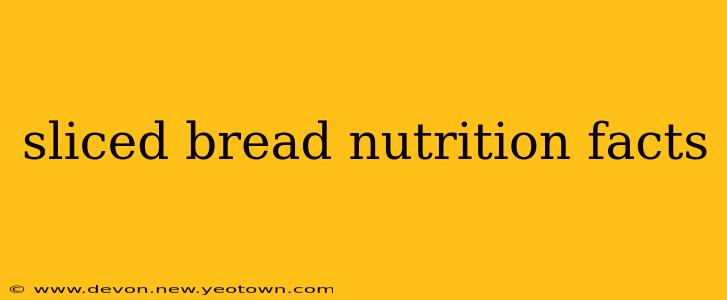Ah, sliced bread. A kitchen staple since its invention in 1928, it's a cornerstone of countless sandwiches, toast creations, and even French toast adventures. But have you ever stopped to consider what's really in that humble slice? Let's delve into the world of sliced bread nutrition facts, separating the myths from the realities.
This isn't just about numbers on a label; it's about understanding how your daily bread choices impact your overall health and well-being. We'll unpack the nutritional content, address common questions, and help you make informed choices for your diet.
What are the basic nutritional facts for a slice of bread?
This is where things get interesting because the nutritional content varies wildly depending on the type of bread. A single slice of white bread might boast around 70-80 calories, while a slice of whole wheat can easily reach 90 or more. The difference lies in the ingredients.
White bread, often made with refined flour, is generally higher in carbohydrates and lower in fiber. Whole wheat bread, on the other hand, retains the bran and germ of the wheat kernel, packing a punch of fiber, vitamins, and minerals. Think of it like this: white bread is a quick energy boost, while whole wheat bread provides sustained energy and important nutrients.
Beyond calories, consider these key nutritional components:
-
Carbohydrates: This is the bread and butter (pun intended!) of bread's nutritional profile. Carbohydrates provide energy, but the type of carbohydrate matters. Simple carbs (like in white bread) are quickly digested, leading to energy spikes and crashes. Complex carbs (like in whole wheat bread) are digested more slowly, providing sustained energy.
-
Fiber: Whole wheat bread is a star player in the fiber department. Fiber is crucial for digestive health, helps regulate blood sugar, and can even contribute to weight management.
-
Protein: Bread offers a modest amount of protein, though it's not a primary protein source.
-
Vitamins and Minerals: The vitamin and mineral content varies greatly depending on the type of bread and any added nutrients. Whole wheat bread generally contains more iron, B vitamins, and other essential nutrients.
How many calories are in a slice of bread?
As mentioned earlier, the calorie count varies greatly. A typical slice of white bread might contain 70-80 calories, while a slice of whole wheat could have 90-100 calories, or even more depending on the brand and ingredients. Always check the nutrition label on the specific bread you're consuming for the most accurate information. Factors like added ingredients (seeds, nuts, etc.) can also impact the calorie count.
What are the ingredients in a typical slice of bread?
The ingredient list is where the real story unfolds. A simple white bread might list just flour, water, yeast, and salt. However, many breads contain additional ingredients like sugar, high-fructose corn syrup, preservatives, and emulsifiers. Whole wheat bread generally has a shorter and more recognizable ingredient list, often including whole wheat flour, water, yeast, and a minimal amount of other ingredients.
Checking the ingredient list allows you to make informed choices about added sugars, preservatives, and other additives you might want to limit in your diet.
Is sliced bread healthy?
The healthfulness of sliced bread depends entirely on which sliced bread you choose. White bread, with its refined flour and often added sugars, is less nutritious compared to whole wheat bread. Whole wheat bread, with its fiber and nutrients, is a far healthier choice. The key is to opt for options with minimal added sugars and preservatives, and prioritize whole grains over refined grains.
What is the best type of bread to eat?
The "best" type of bread depends on your individual dietary needs and preferences. However, generally, whole wheat bread and other whole-grain varieties are considered the healthiest choices due to their higher fiber content, vitamins, and minerals. Look for breads with whole grains listed as the first ingredient.
In conclusion, understanding sliced bread nutrition facts is key to making healthy choices. The next time you reach for a loaf, take a moment to examine the nutrition label and ingredient list. Choose wisely, and enjoy your bread!

